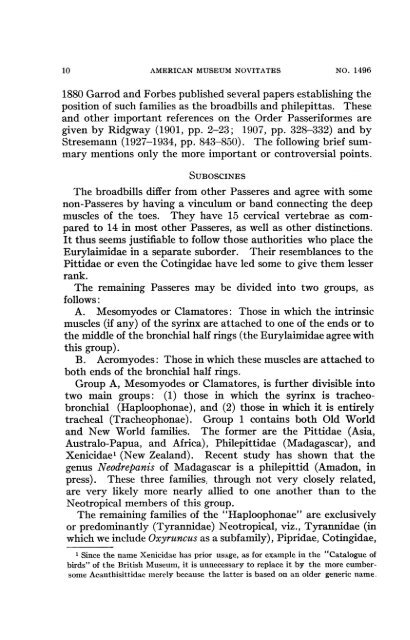NOVITATES - American Museum of Natural History
NOVITATES - American Museum of Natural History
NOVITATES - American Museum of Natural History
You also want an ePaper? Increase the reach of your titles
YUMPU automatically turns print PDFs into web optimized ePapers that Google loves.
10 AMERICAN MUSEUM <strong>NOVITATES</strong> NO. 1496<br />
1880 Garrod and Forbes published several papers establishing the<br />
position <strong>of</strong> such families as the broadbills and philepittas. These<br />
and other important references on the Order Passeriformes are<br />
given by Ridgway (1901, pp. 2-23; 1907, pp. 328-332) and by<br />
Stresemann (1927-1934, pp. 843-850). The following brief summary<br />
mentions only the more important or controversial points.<br />
SUBOSCINES<br />
The broadbills differ from other Passeres and agree with some<br />
non-Passeres by having a vinculum or band connecting the deep<br />
muscles <strong>of</strong> the toes. They have 15 cervical vertebrae as compared<br />
to 14 in most other Passeres, as well as other distinctions.<br />
It thus seems justifiable to follow those authorities who place the<br />
Eurylaimidae in a separate suborder. Their resemblances to the<br />
Pittidae or even the Cotingidae have led some to give them lesser<br />
rank.<br />
The remaining Passeres may be divided into two groups, as<br />
follows:<br />
A. Mesomyodes or Clamatores: Those in which the intrinsic<br />
muscles (if any) <strong>of</strong> the syrinx are attached to one <strong>of</strong> the ends or to<br />
the middle <strong>of</strong> the bronchial half rings (the Eurylaimidae agree with<br />
this group).<br />
B. Acromyodes: Those in which these muscles are attached to<br />
both ends <strong>of</strong> the bronchial half rings.<br />
Group A, Mesomyodes or Clamatores, is further divisible into<br />
two main groups: (1) those in which the syrinx is tracheobronchial<br />
(Haploophonae), and (2) those in which it is entirely<br />
tracheal (Tracheophonae). Group 1 contains both Old World<br />
and New World families. The former are the Pittidae (Asia,<br />
Australo-Papua, and Africa), Philepittidae (Madagascar), and<br />
Xenicidael (New Zealand). Recent study has shown that the<br />
genus Neodrepanis <strong>of</strong> Madagascar is a philepittid (Amadon, in<br />
press). These three families, through not very closely related,<br />
are very likely more nearly allied to one another than to the<br />
Neotropical members <strong>of</strong> this group.<br />
The remaining families <strong>of</strong> the "Haploophonae" are exclusively<br />
or predominantly (Tyrannidae) Neotropical, viz., Tyrannidae (in<br />
which we include Oxyruncus as a subfamily), Pipridae, Cotingidae,<br />
1 Since the name Xenicidae has prior usage, as for example in the "Catalogue <strong>of</strong><br />
birds" <strong>of</strong> the British <strong>Museum</strong>, it is unnecessary to replace it by the more cumbersome<br />
Acanthisittidae merely because the latter is based on an older generic name.

















